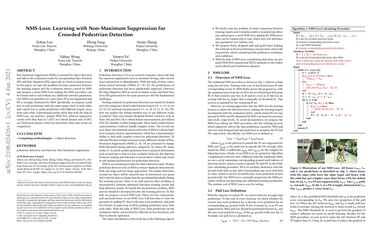NMS-Loss: Learning with Non-Maximum Suppression for Crowded Pedestrian Detection
Non-Maximum Suppression (NMS) is essential for object detection and affects the evaluation results by incorporating False Positives (FP) and False Negatives (FN), especially in crowd occlusion scenes. In this paper, we raise the problem of weak connection between the training targets and the evaluation metrics caused by NMS and propose a novel NMS-Loss making the NMS procedure can be trained end-to-end without any additional network parameters. Our NMS-Loss punishes two cases when FP is not suppressed and FN is wrongly eliminated by NMS. Specifically, we propose a pull loss to pull predictions with the same target close to each other, and a push loss to push predictions with different targets away from each other. Experimental results show that with the help of NMS-Loss, our detector, namely NMS-Ped, achieves impressive results with Miss Rate of 5.92% on Caltech dataset and 10.08% on CityPersons dataset, which are both better than state-of-the-art competitors.
PDF Abstract






 CityPersons
CityPersons
